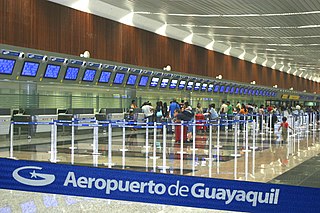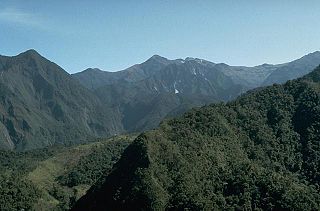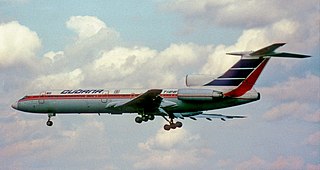
Luis Muñoz Marín International Airport is a joint civil-military international airport located in suburban Carolina, Puerto Rico, three miles (5 km) southeast of San Juan. It is named for Luis Muñoz Marín, Puerto Rico's first democratically elected governor, and was known as Isla Verde International Airport until it was renamed in February 1985. It is the busiest airport in the Caribbean region by passenger traffic. Over 4 million passengers board a plane at the airport per year according to the Federal Aviation Administration, making it the 48th busiest airport overseen by said federal agency.

Tocumen International Airport is the primary international airport serving Panama City, the capital of Panama. The airport serves as the homebase for Copa Airlines and is a regional hub to and from the Caribbean, South, North and Central America and additionally features routes to some European cities as well as cargo flights to Qatar, a country in Asia.

El Dorado International Airport is an international airport serving Bogotá, Colombia, and its surrounding areas. The airport is located mostly in the Fontibón district of Bogotá, although it partially extends into the Engativá district and through the municipality of Funza in the Western Savanna Province of the Cundinamarca Department. It served over 39 million passengers in 2023 making it the second busiest airport in South America and 3rd overall in Latin America in terms of passenger traffic. As well as being the 32nd busiest airport in the world in 2022. With 760,000 metric tons of cargo passing through the same year, it is also Iberoamerica's most important cargo hub. El Dorado is also by far the busiest and most important airport in Colombia, accounting for just under half (49%) of the country's air traffic. The facility covers 1,700 acres (6.9km2) and contains two 3,800m long runways. El Dorado has non-stop international flights to North America, South America, Central America, the Caribbean, Europe, and the Middle East.

TAME or TAME EP Linea Aerea del Ecuador was an airline founded in Ecuador in 1962. TAME was the flag carrier and the largest airline of Ecuador. TAME headquarters were in Quito, Pichincha Province and the main hub was Mariscal Sucre International Airport in Quito. The airline was formed by the Air Force of Ecuador. In 2011, it became a commercial entity and provided domestic, international and charter flights. On May 20, 2020, the Ecuador government decided to cease all the operations and liquidate the airline.

José Joaquín de Olmedo International Airport is an international airport serving Guayaquil, the capital of the Guayas Province and the most populous city in Ecuador. It is the second busiest airport in Ecuador.

La Aurora International Airport serves Guatemala City, Guatemala. It is located 6.4 kilometres south of Guatemala City's center and 25 km from Antigua Guatemala. It is administered by the General Directorate of Civil Aeronautics.

José María Córdova International Airport is an international airport located in the city of Rionegro, 20 kilometres (12 mi) south-east of Medellín, and is the second largest airport in Colombia after El Dorado International Airport of Bogotá in terms of infrastructure and passenger service. The airport is named after José María Córdova, a Colombian army general who was a native of Ríonegro.

The Fairchild F-27 and Fairchild Hiller FH-227 were versions of the Fokker F27 Friendship twin-engined, turboprop, passenger aircraft manufactured under license by Fairchild Hiller in the United States. The Fairchild F-27 was similar to the standard Fokker F27, while the FH-227 was an independently developed, stretched version.

Icaro Air was an airline based in Quito, Ecuador. Its main base was Mariscal Sucre International Airport, Quito.
SAETA Air Ecuador was a privately held airline of Ecuador, which was founded in 1966. During its heyday in the 1990s, it flew to numerous destinations in North and South America from its base in Guayaquil.
Vuelos Internos Privados S.A. was an Ecuadorian regional airline based at the Old Mariscal Sucre International Airport and headquartered in Quito, Ecuador. It operated domestic and regional services. The airline was a subsidiary of Avianca and part of the AviancaTaca Holding, which was owned by Synergy Group.

Mariscal Lamar International Airport is a high elevation airport serving Cuenca, the capital of the Azuay Province in Ecuador. It is named after the Peruvian military leader and politician José de la Mar, a native of Cuenca.

Air France Flight 422 was a scheduled flight on 20 April 1998 by Air France from Bogotá, Colombia, to Quito, Ecuador, covering the final leg of a flight from Paris to Quito. The Boeing 727 was destroyed, killing all 53 people on board, when it crashed into the Eastern Hills of Bogotá because of foggy weather and low visibility after taking off from Bogotá's El Dorado International Airport. The plane was owned by TAME, the Ecuadorian airline, but was being operated on a wet-lease basis to Air France as the final leg of its flight from Paris.
SAN was an airline which was based in Guayaquil, Ecuador that was the domestic branch of the airline SAETA. It was founded in 1964, and ceased operations in 1999.

Atacazo is a volcano of the Western Cordillera located 25 kilometers southwest of Quito, Ecuador. Atacazo is a stratovolcano formed by the action of a Late-Pleistocene to Holocene caldera. The last eruption of the Atacazo was nearly 2300 years ago.

The 1983 TAME Boeing 737 crash occurred when A Boeing 737-200, operated by Ecuador's national airline TAME, flying on a domestic route from the now-closed Mariscal Sucre International Airport in Quito to Mariscal Lamar Airport in Cuenca, crashed into a hill during final approach just 1 mile from its final destination, killing all 119 people on board.

Mariscal Sucre International Airport is an international airport serving Quito, Ecuador. It is the busiest airport in Ecuador. It is located in the Tababela parish, about 18 kilometres (11 mi) east of Quito, and because of its location it is also colloquially known as Tababela Airport. The airport currently serves as the main hub for Avianca Ecuador and the largest hub for LATAM Ecuador. It also served as the main hub for TAME, Ecuador's flag-carrier, before the airline was liquidated by the Ecuadorian government in 2020. The airport opened in February 2013 and replaced the 53-year old airport of the same name. The airport is named after independence leader Antonio José de Sucre. It was the first 5-star airport in the Western Hemisphere as rated by Skytrax.

Cubana de Aviación Flight 389 (CU389/CUB389) was a scheduled international passenger flight, flying from the former Mariscal Sucre International Airport in Quito to Havana's José Martí International Airport, with a stopover at Simón Bolívar International Airport in Guayaquil, operated by Cuban flag carrier Cubana de Aviación.

Aeroservicios Ecuatorianos Flight 767-103 was a scheduled freight flight from Miami in the United States to Guayaquil, Ecuador with an intermediate stop in the Ecuadorian capital Quito. On 18 September 1984 the flight was being operated by a Douglas DC-8-55F jet. It failed to get airborne during the takeoff run at Quito Airport, hit an Instrument Landing System (ILS) antenna at the end of the runway and then struck several houses. All four crew and 49 people on the ground were killed.

Jumandy Airport is an airport serving Tena, Napo Province, Ecuador. It is 3 kilometres (1.9 mi) west of the village of Ahuano, and about 25 kilometres (16 mi) from Tena. It replaces Tena's Mayor Galo de la Torre Airport, which closed in 2001.



















